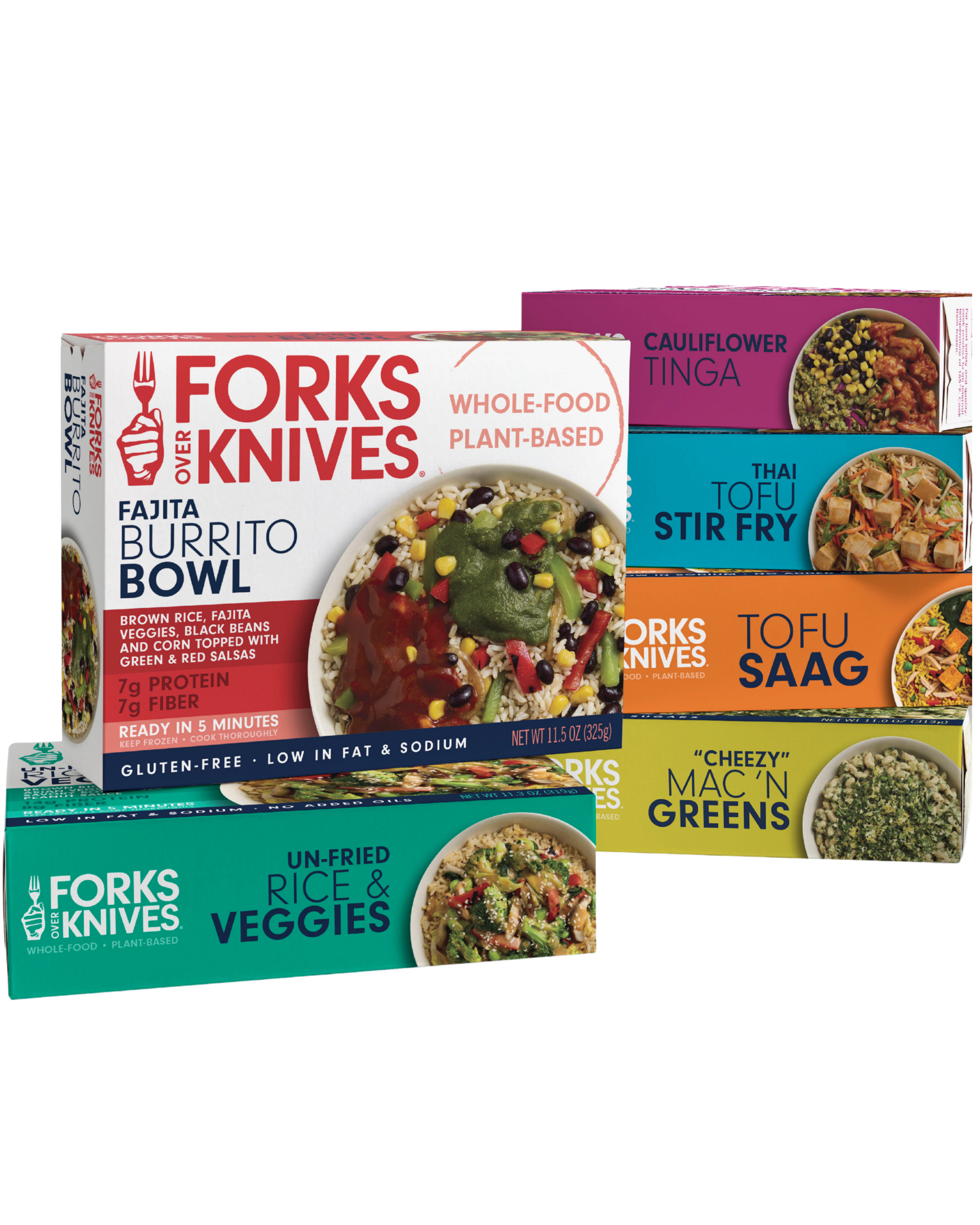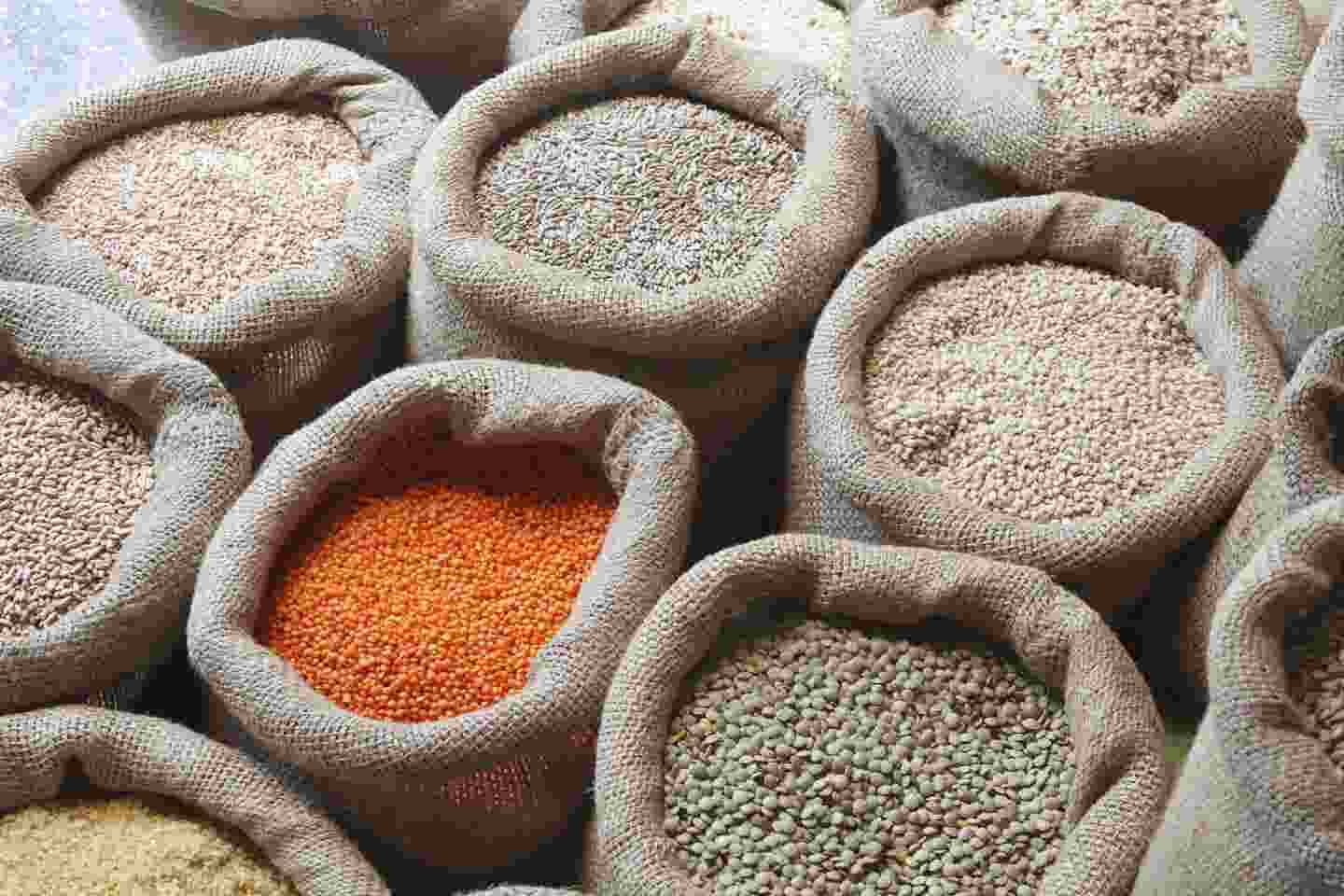Once weaned, children are just like small adults when it comes to nutrition. Starches (potatoes, corn, rice, sweet potatoes, beans, etc.) must provide the bulk of their calories in order for them to thrive. Meat and dairy products, along with oils and simple sugars, make them fat and sick. You never need to worry about children getting enough protein, essential amino acids, calcium, iron, zinc, or essential fats when they are eating a starch-based diet, as I recommend. However, extra attention does need to be paid to providing sufficient calories for growth.
Food industries have built their customer bases with the marketing strategy of “unique positioning,” where each big business tries to make its food product stand apart by overly promoting one of its more plentiful nutrients. Their efforts have been very effective, and as a result, calcium has become synonymous with dairy foods, as has protein with meat, poultry and eggs, iron with beef, and essential omega-3 fats with fish. Without these animal-derived foods in their daily diets, the public, both lay and professional, has come to believe that people, and especially children, will suffer from deficiencies. These beliefs are scientifically untrue, as discussed in detail in my book The Starch Solution.
The undeniable consequence of these multibillion-dollar promotions of unhealthy foods has been a pandemic of chronic illnesses among children living in Western countries. One in every three children in the US is now overweight or obese, and underneath all that extra body fat is sickness. Weight gain lays the foundation for type-2 diabetes. Sadly, one-third of all children born in the year 2000 are expected to develop diabetes during their lifetime. Additionally, artery disease (atherosclerosis), leading to strokes and heart attacks, and common cancers of the breast, colon and prostate, also begin in childhood. These trends have led to the conclusion that the current generation is expected to have a shorter lifespan than their parents. Misinformation about the nutritional needs of children is the first and foremost stumbling block to regaining their lost health and appearances.
Industry, working with government, actively spreads lies about the superiority of animal-derived nutrients. For example, cattle rancher and US representative from Wyoming, Cynthia Lummis, introduced congressional bill HR 804 on September 21, 2012. This resolution asks that the US House of Representatives: “(1) recognizes the importance of animal-based protein as a component of the balanced diet of most individuals in the United States, and (2) encourages the Department of Agriculture to continue promoting the health benefits of and consumption of animal-based protein under the science-based 2010 Dietary Guidelines for Americans.” You must defend your own family because help is unlikely to come from outside.
Common Concerns of Parents
Setting aside personal preferences for the taste of eating animals and the huge profits for the food and medical businesses, the scientific truth is that your child will thrive on a starch-based, animal product-free diet and avoid diseases now commonly found among his or her peers and classmates. Parents and children must become familiar with the nutritional facts in order to avoid everyday pitfalls.
Protein:
The greatest time of growth in a child’s life happens during his or her first two years. The ideal diet during these nutritionally demanding times is breast milk. The protein content of human breast milk is a mere 5% of total calories. This low protein level cannot be reached by unrefined plant foods (starches and vegetables), as most plant foods have protein levels that are higher. Consider that sweet potatoes are 6%, rice 8%, potatoes 10%, and beans 28% protein. Plants synthesize all of the essential amino acids (animals can make only half of these building blocks of life), therefore, getting adequate protein in a child’s diet should not be a concern if they are on my starch-based diet.
Calcium:
This mineral originates from the soil and directly or indirectly enters all animals through plants. Calcium from plant foods grows sturdy horses and strong elephants. Obviously, supplying the mineral needs of children is easily accomplished with plants. A recent review from the journal Pediatrics provides reassurance to parents that dairy is unnecessary for children to obtain adequate calcium. Meat, poultry and eggs contain essentially no calcium at all. Calcium deficiency is not of concern on my starch-based diet.
Omega 3 fats:
The brain, a fatty tissue, is growing rapidly during childhood. This has lead people to believe that super concentrated sources of essential fats from foods are required. Only plants can synthesize the basic essential fats (omega-3 and -6). It is true that animals (fish, for example) do elongate these basic plant-derived building blocks into other fats (like EPA and DHA), however, children, also being efficient animals, do the same. No fish or other animal needs to help. Essential fat deficiency is not of concern on my starch-based diet.
Iron:
This mineral originates from the soil, and directly or indirectly enters all animals through plants. Concern about low iron, especially for the very young, has caused an organization, Health Canada, to recommend meat be given to babies as their first solid food. Please note that members of this organization have ties to the pharmaceutical and food industries. Rather than remove the cause, cow’s milk, of almost all iron deficiency anemia in infants, their recommendation is to supplement with more iron from meat.
Cow’s milk contains almost no iron. Compounding this problem of iron availability is that the calcium and casein in cow’s milk prevents the absorption of iron into the child’s body. Iron loss completes the triad of mechanisms causing iron deficiency: cow’s milk causes about 40% of otherwise healthy infants to bleed from their intestines. Feeding meat as baby’s first food does not fix the problem and creates many others (obesity, type-2 diabetes, artery disease, cancer, etc.). An important nutritional distinction is that human breast milk enhances iron absorption, and thus iron deficiency is not a problem for exclusively breastfed infants. Plants are loaded with iron from the soil and easily meet children's nutritional needs (as long as they avoid dairy products). Iron deficiency is not of concern on my starch-based diet.
Vitamin D:
Infants and children need sunshine for many reasons, including the production of vitamin D. The amount of exposure depends on factors such as skin pigmentation, latitude, season of year, and time of day. In general, about two hours a week of exposure to face and hands is sufficient for light-skinned children. Vitamin D supplements will not replace sunshine and have multiple adverse effects. I do not recommend vitamin D supplements in the forms of fortified-foods or pills (except under extreme situations). Vitamin D is not of concern on my starch-based diet.
Vitamin B12:
Bacteria found in the environment and the human intestine produce vitamin B12. Meat contains vitamin B12 originally synthesized by bacteria. At least in part, because of the sanitary conditions, antiseptics, and antibiotics emphasized in our modern society, there is a risk of vitamin B12 deficiency. To cover this rare possibility, children should take vitamin B12 supplements. Five micrograms (mcg) daily is sufficient and appears to be non-toxic even at the high dosages commonly found in stores (500 to 5000 mcg per dose). Vitamin B12 is not of concern on my starch-based diet with my recommendations of a supplement of B12.
Height and Sufficient Calories:
If a child’s diet contains sufficient calories, then normal growth and development can be expected. Children do need energy for growth (protein, calcium, and essential fats are never limiting factors). Starches (rice, corn, potatoes, etc.) are goldmines of energy. Adding even more calorie concentrated foods, such as dried fruits, nuts, seeds, nut butters, and avocados, can further enhance calorie intake. Fruit juices are loaded with calories (and simple sugars, so be careful to rinse and brush teeth shortly after drinking to prevent tooth decay).
Final height depends upon calorie intake during childhood, but it is important that these calories come from plants rather than animal sources. Dependence on animal foods results in many health problems, including precocious puberty. Advanced onset of maturity means earlier initiation of sexual activity, more unplanned teenage pregnancies, more female poverty, and more disease later in life (breast cancer, for example). Failure to obtain proper height is not of concern on my starch-based diet.
Diet at Various Ages
Newborn until 6 months:
Breast milk until six months of age should be fed exclusively (no juice, water, formula, etc.). At six months the baby develops teeth to chew solid foods and hand coordination adequate to take anything from mother’s hands. (Exclusive breastfeeding past six months can be healthy for mother and infant.)
Mother’s diet is crucial, too. Her nutrient and non-nutrient intake affects her milk. For example, the cow’s milk protein that she consumes ends up in her breast milk, causing her baby problems, such as colic. Harmful environmental chemicals from her food choices can also poison her milk. Lactating women should include supplemental vitamin B12 as well.
For those few women who cannot breastfeed, I recommend hypoallergenic cow’s milk-based formula (also called protein hydrolysate formulas).
These formulas are commonly described as poor tasting. This is because the manufacturers make them with less sugar than their regular cow’s milk-based formulas. This discrepancy can be fixed by adding 1gram of table sugar (about 1/4 teaspoon) to 2 fluid ounces of formula (100 calories). As baby adjusts, the added sugar can be reduced and stopped. Soy, nut, rice, and oat “milks” and other home-prepared formulas should not be used for infants.
Ages 6 months until 2 years (weaning):
Children naturally love sweet tastes (the tip of the tongue has taste buds for sweet). The first weaning foods introduced at six months may include cooked rice, corn, oat, and other grain cereals and flours, and pureed potatoes and sweet potatoes. Young children enjoy cooked and pureed fruits such as apples, bananas, and pears. Cooked and pureed vegetables are often bitter tasting, thus broccoli, cauliflower, kale, and spinach may be harder to introduce. Cooked beans, green peas, and chunks of tofu can be introduced between seven and eight months of age. Simple healthy snacks such as puffed corn and rice make good finger foods.
Mashed avocados, and nut and seed butters spread on bread, bagels, and crackers can be introduced at about one year. Peanut and other nut allergies are not uncommon. If there is concern because of past or family history, then avoid suspicious foods. Cooked foods are generally better tolerated because the cooking breaks down proteins and carbohydrates making them more digestible and less allergic. Minimize the risk of choking by blending and cutting foods into small pieces.
Foods can be easily and cheaply prepared at home, but many parents choose commercially prepared baby foods. Check the ingredients. They should only contain mashed and cooked grains, vegetables, and fruits with no added salt or sugar.
Ages 2 years until 10 years:
Frequent meals and snacks, as well as large portions, help to insure adequate energy intake. Fats are the most concentrated source of calories. The fat intake of healthy young children can be liberalized. However, children who are already overweight or obese should not be fed high-fat plant foods like nuts, seeds, and avocados until they have lost the excess weight.
Favorite foods for our children and grandchildren have been: cold and hot cereals topped with a half teaspoon of sugar, pancakes and waffles with a small splash of maple syrup, toast with a thin spread of jam, pasta and marinara sauce (vegetables were scary so they were blended with the sauce first), vegetable and bean soups with breads, sandwiches with peanut butter and a thin spread of jelly, sandwiches with bean spreads, bean burritos, healthy pizzas, and rice, potatoes, or pasta with various gravies. They also liked their starches (rice, corn, potatoes, sweet potatoes, peas, beans, pastas, breads, etc.) plain. (Thousands of recipes from Mary are found on my website (free) and in McDougall books. Plus there is a free 12-day program for the family to follow at www.drmcdougall.com.) (Simple sugars, salt, and spices are used to enhance food acceptance, but in reasonable, generally small, amounts.) Water is the best beverage. Herb teas can be acceptable. Fruit juice is sugar and water, so proper rinsing and brushing of teeth is required.
During these ages, parental control should be absolute; food choices should not be up to the discretion of the child. Put the right foods in the cupboards and refrigerator and the child will eat them. (Competing unhealthy foods must be removed.)
Ages 11 years to adulthood:
An important growth spurt occurs during adolescence. Starches must provide the bulk of their calories, with extra energy from dried fruits and high-fat plant foods (nuts, seeds, avocados, etc.). Obesity is a growing problem in these years. Consider that one in four young adults is too overweight to join the US military, according to a new report from an advocacy group. Our country’s safety depends on our military’s strength and endurance, thus obesity and dietary illnesses are a threat to our national security.
Education is the key to getting older children to choose healthy eating. Explain to them how their choices can detract from their personal appearances (from acne to malodor to obesity). Explain how “all winning athletes” are fueled by carb-loading (rice, corn, potatoes, etc.). Animal Rights and environment issues resonate with young, sensitive people looking to their future.
Winning the Future for Our Children
Our children must be protected and healed. We, as parents and grandparents, have that responsibility and many of us have the knowledge to take action now. Unfortunately, most people are still blind to the importance of saving those who are over-fed. They don’t see the pains of an obese child as being as hurtful as those of an under-fed child. But, they are. Widespread suffering in today’s meat and dairy dominated world deserves the same full scale efforts (or greater) that the US took to save the starving children in Western Europe after WWII. My starch-based diet is a 100% effective, low-cost, and harmless way to strengthen the world with a future populated by well-fed, strong, healthy, and fit children.
Originally published in the McDougall Newsletter and republished with permission. Click here to sign-up for the McDougall Newsletter for free.
Related News
Get Our Best Price On The Forks Meal Planner

Forks Meal Planner takes the guess work out of making nutritious meals the whole family will enjoy.
Master Plant-Based Cooking!

Our new course features over 100 lessons, 50+ recipes, downloadable guides, and more!
New Frozen Meals!

Introducing our new frozen meals: Doctor-recommended, chef-crafted, & ready in minutes.




